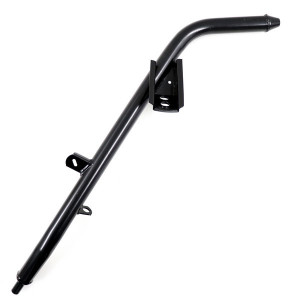Straight suspension leg
Aixam 400sl , 400 Evo , 500sl , 400.4 , 500.4 , 500.5 / First assembly
New
In stock
€37.58
or 4 x 9.39 €
The suspension leg is a crucial piece in the suspension system of a car-free car. It connects the wheel to the chassis, ensures the stability in turn, absorbs the irregularities of the road and maintains the good alignment of the wheels. A suspension leg in good condition contributes greatly to safety, driving comfort, road maintenance and longevity of the entire rolling train.
The suspension leg supports the wheel pivot and allows the wheel to ride and down while ensuring the right orientation with the ground. It transmits the forces of the shock wheels to the chassis and allows a harmonious movement thanks to the flexibility of the components (joints, silent-blocks). It also serves as a guide during vertical trips generated by road imperfections.
• Ball : They allow the pivoting and oscillation between the wheel and the leg, essential to vertical turning and displacement.
• Silent-blocks : rubber or polyurethane elements that isolate vibrations and shocks.
• Fasteners / nuts and bolts : bolts, nuts, media, often subjected to corrosion or game.
• Arm or metal structure : The rigid main part that connects all the elements and must maintain its structural integrity.
• Pivotal points : Zones subjected to friction and wear, often lubricated or greased.
A tired or damaged suspension leg causes perceptible symptoms: knocking noises, cornering, uneven tire wear, direction game, random road handling, vibrations. In addition, a weakeback component may overload on the steering joints, bearings or supports, leading to a more severe failure.
To prevent a suspension leg failure, it is recommended to monitor it periodically, especially after shocks, road trips damaged or in strange noises. Visual and sound control often makes it possible to detect failure indices before they become dangerous.
• Oxidation or corrosion of the metal around the attachment points.
• Apparent game at the ball joints or joints.
• Cracks, deformation of the metal arm.
• Wear or deterioration of silent-blocks.
• Visible oil leakage if the leg is associated with a faulty hydraulic element or sealing.
• Blancings or knockings during bumps or hollow.
• Less accurate, floating direction in turns.
• Vibrations felt in the steering wheel or on the chassis.
• Fast and uneven wear of front tires.
• Drift of the vehicle on one side despite adjustment of parallelism.
Depending on the status of the suspension leg, several strategies are available to you. You can opt for targeted repair if the damage is limited or a complete replacement when the structure or critical components are damaged.
• Replace the pivotal ballpoint if it is worn or noisy.
• Change the silent-Déterior or cracked blocks.
• Replace corroded or loose or loose bolts.
• Check the adjustment and tightening according to the manufacturer's specifications.
• Lubricate the pivot points if applicable.
• Install a new or adaptable suspension leg of quality.
• Replace all degraded peripheral components at the same time (Balls, Silent-blocks, fasteners).
• Check the geometry of the train before replacement.
• Test driving to detect any handling anomaly.
Pro VSP Offers a wide range of suspension legs adapted to all car-free car brands: origin, adaptable, reinforced parts. You will find joints, silent-Blocks, fasteners, arms and supports. Product cards specify compatibilities, dimensions and fixing points to help your choice with confidence.
During the intervention on a suspension leg, it is advisable to also check the associated damper. Pro VSP proposes a complete assortment ofcar shock absorbers without a license, who work together with the suspension leg to restore comfort, handling and safety.
The cost of a suspension leg depends on the brand, the original or adaptable type, state (nine or reboot) and necessary peripheral parts. Add the mounting fees, the geometry setting and accessories (joints, silent-blocks, supports).
• Cost of the suspension leg she-same.
• Balls, Silent-Associated blocks and supports.
• New fixations, bolts and auxiliary parts.
• Hand-for assembly and disassembly.
• Setting the geometry (parallelism) and control after road tests.
• Check that the suspension leg is properly identified for your car without a license (brand, fixing points, dimensions).
• Privilege original parts or certified adaptable.
• Replace the peripheral parts at the same time as the leg.
• Make a good assembly, observe the tightening torques and replace the worn fasteners.
• Test the pipe after mounting to check comfort, noise and handling.
Also find our community on our forum Avenir VSP !
